When we started looking into what traditional Scottish food to make, Tattie Scones were one of the first things mentioned by our friends. They also said it would be really easy to make… but we’ll get to that!
It’s a well-known fact that no full Scottish breakfast is complete without a tasty tattie scone, so it seemed like a great starting point for making Scottish food.
Luckily, we soon got the hang of it and can now share our traditional Tattie Scone recipe with you too!
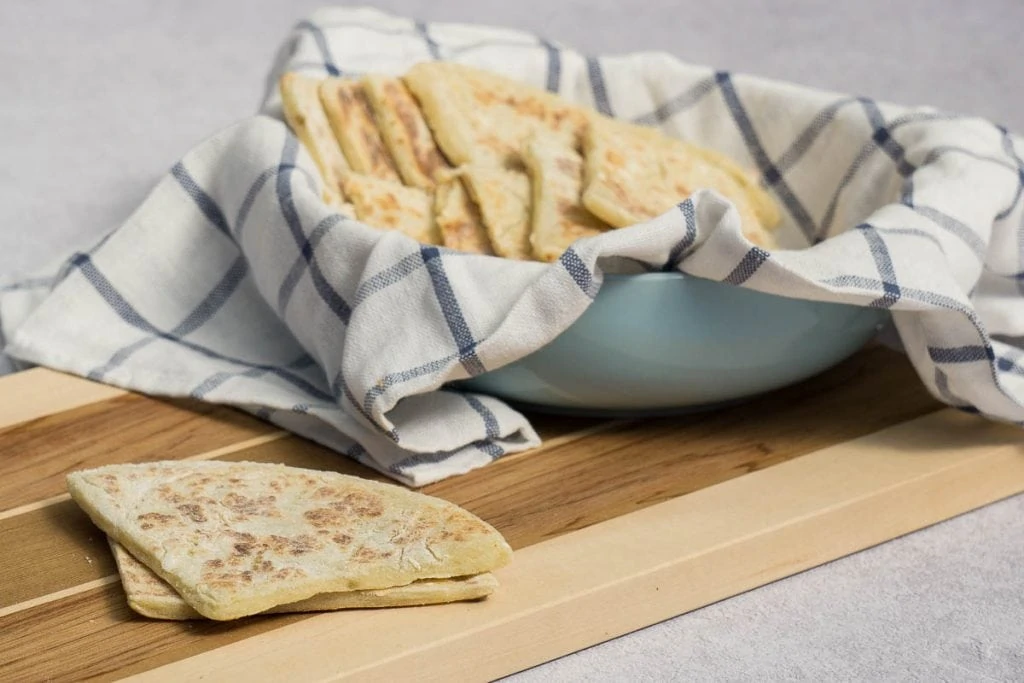
Our first couple of attempts at making Scottish tattie scones, however, didn’t really go as planned.
Numerous tattie/potato scone recipes said they were “easy”, and yet we ended up with tough and chewy scones the first time around, and undercooked tattie scones the second time.
However, when we finally made it work, our tattie scones were divine! Light and delicious, and just perfect with a cooked breakfast or even with butter and jam.
When you know what you’re doing, it’s an easy dish to recreate, but you need the full instructions on how to get there.
I kept saying to Phil that I just wished there was someone in the kitchen to show me where I was going wrong. So we’ve laid out all our tricks so we can be that person for you!
Scroll to the end or use the table of contents to be taken straight to the Printable Recipe Card.
- Why are they called tattie scones?
- How do you eat a tattie scone?
- Why make tattie scones?
- Things you’ll need to make Tattie Scones
- Ingredients for Tattie Scones
- How to Make Tattie Scones – Step by Step
- Our top tips for getting the perfect tattie scones
- Tattie Scones Printable Recipe Card
- Other Similar Scottish Recipes to Try
Why are they called tattie scones?
Tattie is another word for potato, commonly used across Scotland, where tattie scones originated. You might hear them called Tottie in Glasgow and fadge or potato bread in Ireland.
You’ll also hear it in relation to Mince & Tatties, Tattie Soup, and Haggis Neeps & Tatties. All of which you’ll also find recipes for on our site!
Potatoes are definitely a strong feature of Scottish food. You’ll also find them in Stovies, and Scottish Macaroons – yes, that’s right, a sweet made of potato!
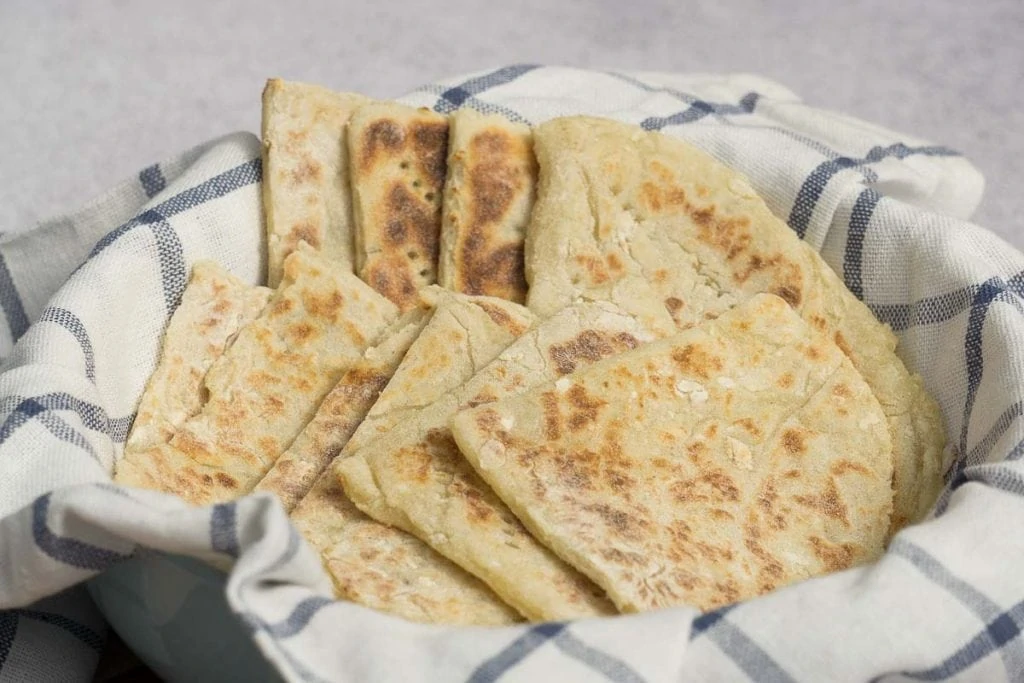
How do you eat a tattie scone?
There are a few different ways to enjoy a tattie scone but it’s most commonly found alongside a full Scottish Breakfast.
The exact items a Full Scottish consists of can be a bone of contention and it’s not to be confused with a Full English!
You’ll generally find it includes most of the following; eggs, bacon, link sausage or square/Lorne sausage (another Scottish speciality), baked beans, black pudding, haggis, fried tomatoes and mushrooms, possibly even fruit pudding (not what you might think) and toast.
Plus, of course, a tattie scone or two!
The tattie scone is fried in the remnants of the bacon fat or in butter and can be used to mop up the egg yolk or eaten with a bit of brown sauce. Delicious!
If a Full Scottish isn’t for you, you can pop your tattie scone in a bread roll (known as a morning roll here!) with other breakfast items, or eat straight from the toaster with a slather of butter.
Finally, some people even enjoy theirs with butter and jam, like traditional scones.
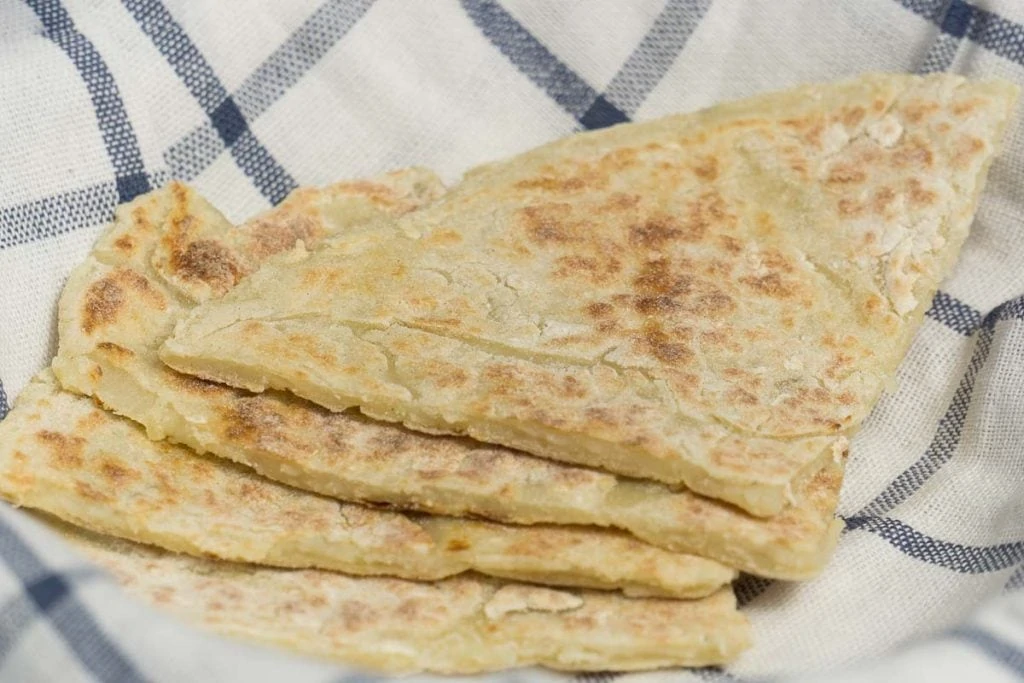
Why make tattie scones?
Tattie scones are pretty cheap to buy in supermarkets across Scotland, but they’re not quite the same as the homemade variety. Homemade tattie scones turn out soft and light rather than stiff and a little salty like the bought kind.
Making your own offers a little extra something to a cooked breakfast and really gives you a taste of Scotland.
Traditionally Tattie Scones would have been made after a midday meal when any leftover potatoes were still warm. They’d be cooked on a dry girdle (griddle), liberally smeared with butter and rolled up to eat. Any cold leftovers could be re-heated by toasting or frying with butter.
This recipe really is simple once you learn one or two tricks to help you make it work along the way. It’s something a little bit different from making bread and uses up potatoes when you need to.
Not only can the potato scones be eaten in a variety of delicious ways, but they also freeze well too!
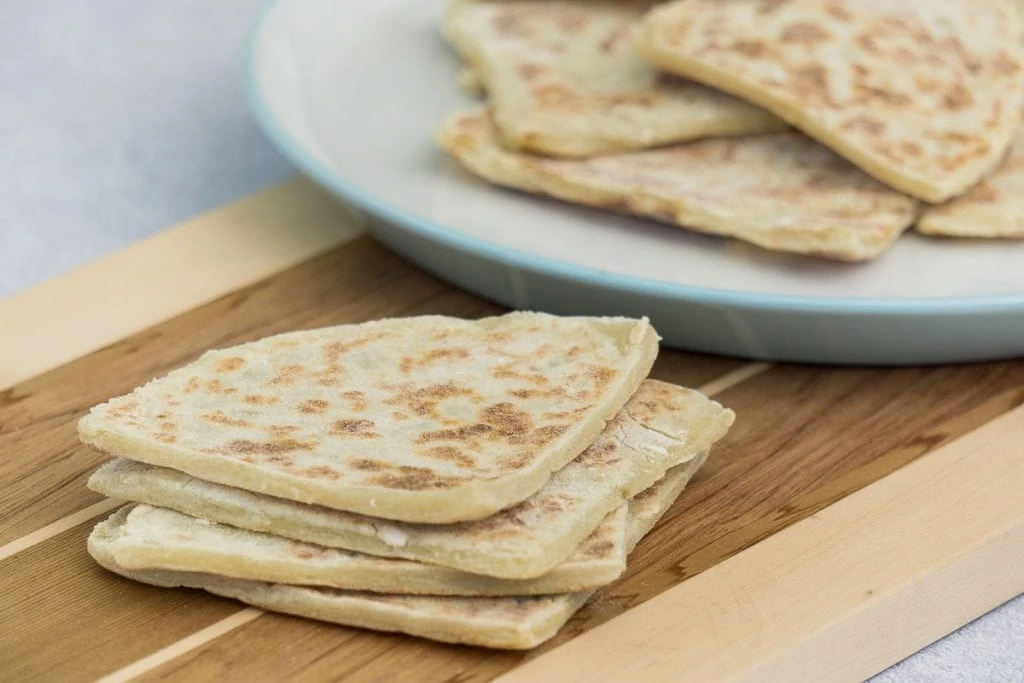
Things you’ll need to make Tattie Scones
While a girdle or griddle pan is often recommended for making Scottish Potato Scones (and many other Scottish foods in fact) it’s not strictly necessary.
You can make them in a large flat-bottomed frying pan as well.
Other than that, you’ll need a pan to boil the potatoes in, of course, and a masher.
If you have a potato ricer, this is useful to get all of the lumps out and make the potato a little fluffier, but again, not necessary and plain old mashed potatoes will do!

Ingredients for Tattie Scones
The ingredients for tattie scones are simple:
- 500g Potatoes
- 125g Plain Flour
- 20g Butter
That’s it! You don’t need anything else, except maybe a pinch of salt.
There are recipes floating about that include an egg, but this makes it more of a fritter than a traditional tattie scone, and it shouldn’t be needed to bind the scone together if you follow the step-by-step method below.
The amount of each ingredient varies depending on how many you want to make and what type of potatoes you use.
King Edward potatoes are generally considered to be the best option because they are light and floury when cooked.
Our recipe makes roughly 12 scones depending on how big you cut them but you can easily do more or less.
Plain flour is preferred over self-raising as you don’t actually want the potato scones to rise at all, they should stay flat and thin.
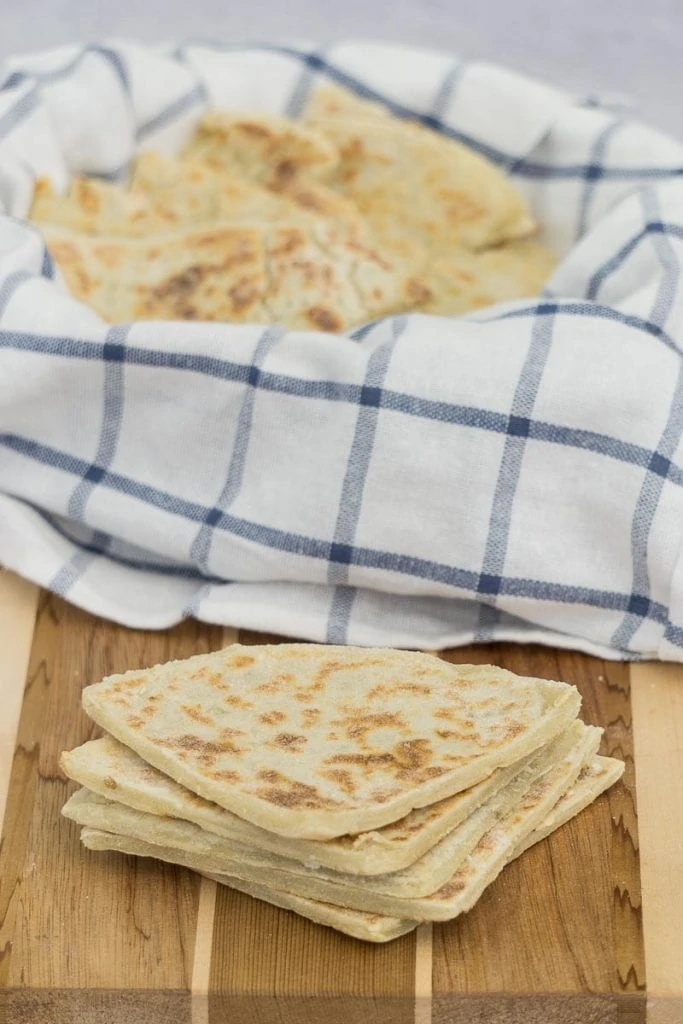
How to Make Tattie Scones – Step by Step
There’s a common misconception that Tattie Scones are made from leftover mashed potato.
While it’s certainly possible to make them with leftovers they won’t be as light and fluffy as potato scones made with still-warm freshly boiled potatoes.
We peeled our potatoes because we found that easier, but you can boil the potatoes in the skins and carefully remove them afterwards too.
The recipe calls for 500g but we weighed them before peeling and boiling so you’ll lose a little weight which is fine.

Don’t cut the potatoes too small if you peel them, just make them as small as the smallest potato you use or cut in large chunks/halves to allow for a nice and even cook.
Once the potatoes are boiled drain the water and allow them to air dry for a few minutes. This will help to remove some more of the moisture.
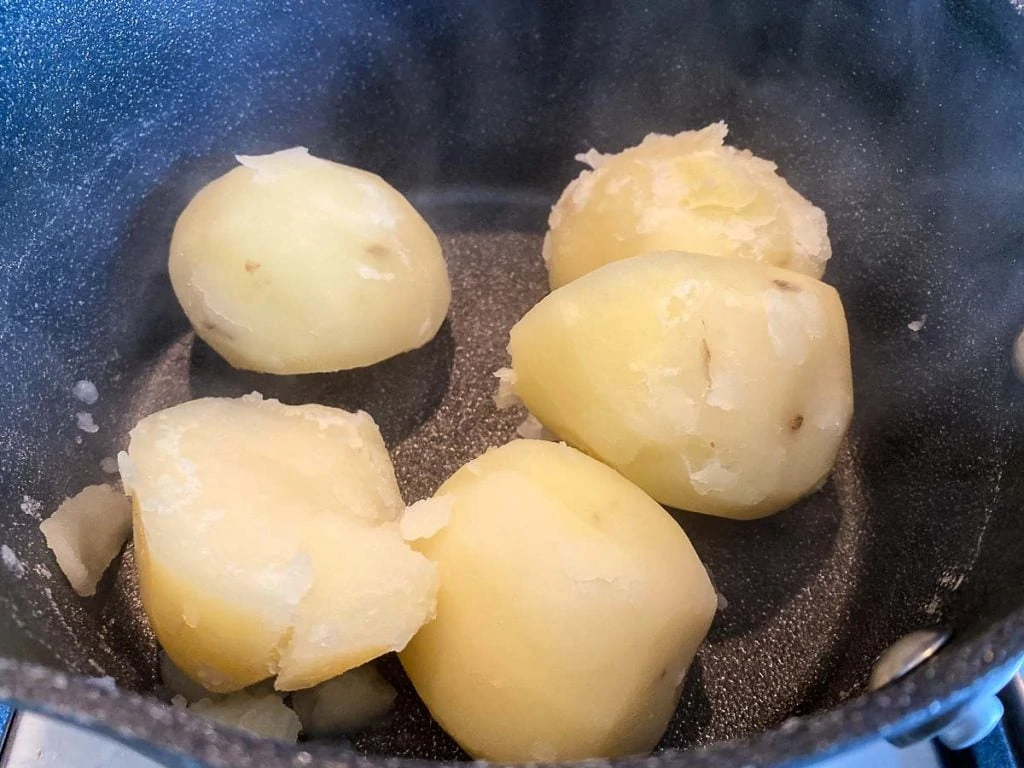
Next, add in the butter, ideally softened to room temperature, and mash well to remove any lumps.
Adding the flour is the next step and how much you use depends on the potatoes. Here’s where you may need to go a bit off-piste! I measured out 125g of flour but keep more on hand to add as you flatten out the tattie scones later.
Add the flour slowly, one tablespoon or so at a time to make sure it’s thoroughly mixed into your mash and that you don’t add more than necessary.
The potatoes should come together to form a stiff dough, once you see this happening you can stop adding flour and turn them out onto a floured surface. I used a wooden chopping board as our worktop proved too sticky.
Separate the dough into 3 even-sized balls, adding in a little flour whenever you need to to ensure it doesn’t stick to anything.
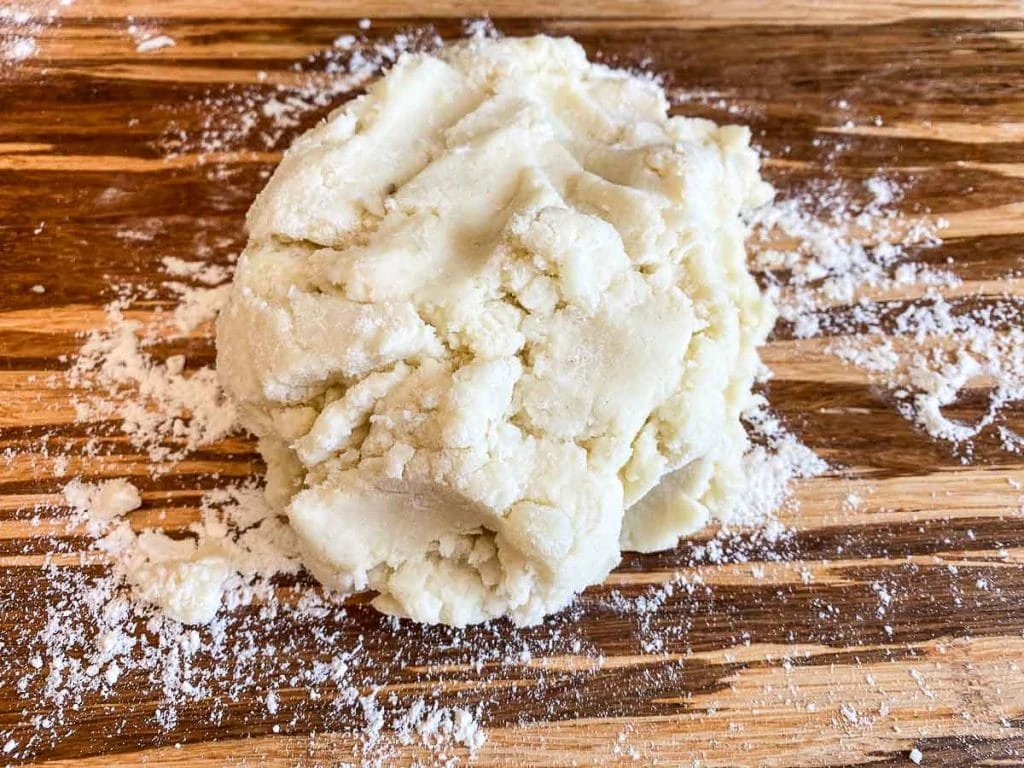
Now importantly, leave these to cool just a little!
While you want to use warm potatoes to get fluffy tattie scones, you won’t be able to make the dough thin enough or shape and lift it into a pan to cook if it’s still too hot, it will just break apart when lifting or stick to the surface. You don’t need long, maybe only 5 minutes or so.
Most of the recipes we researched said to now “roll” out the dough into rounds, but I found that when using a rolling pin to do so it would just stick to the surface immediately. Instead, I did this by patting them with my hands, constantly flipping and adding a little flour as I did so, to prevent them from sticking into the board.
You’re aiming for roughly the size of a side-plate and you can actually place one on top and cut around it to get a perfect circle once it’s big enough.
Remember to keep flipping and lightly flouring so they don’t stick!

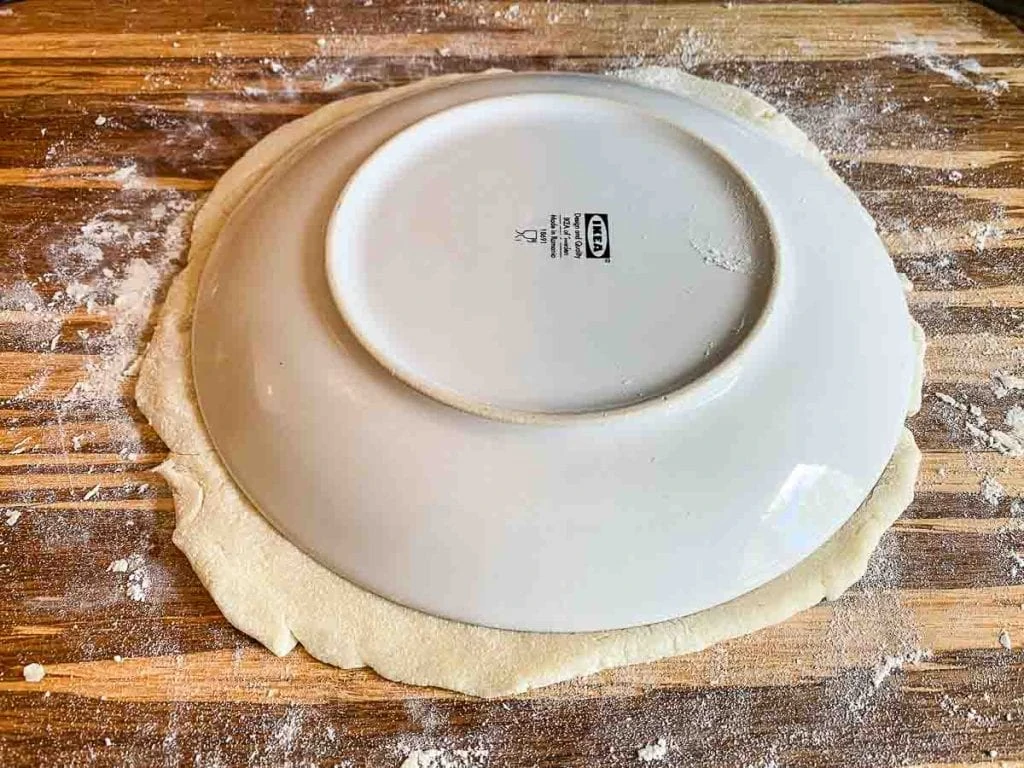
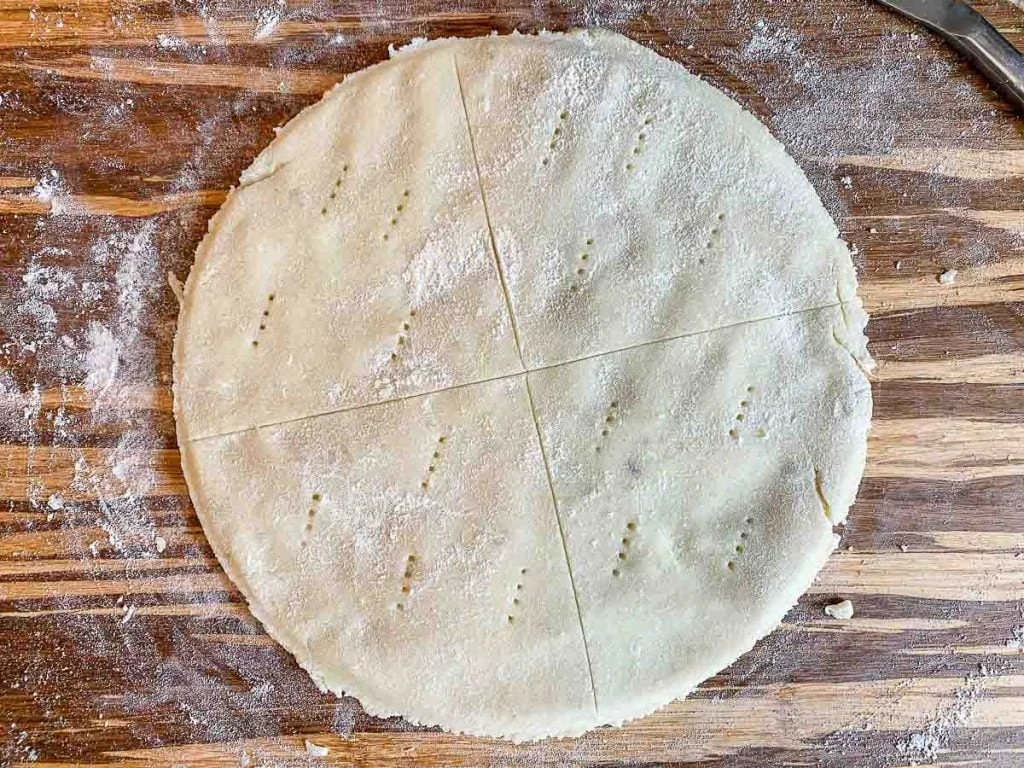
I did them one at a time but if you have a big enough workspace you can do all three. You want them to be about 5mm thick, or slightly less.
Once you have a circle then you can score into 4 and prick all over with a fork. There are two options for cooking. Fry it whole and then cut into 4 afterwards, or cut into 4 and fry individually. It’s easier to do it individually but I quite liked doing them whole as well and then cutting after. I’ve shown both options below.
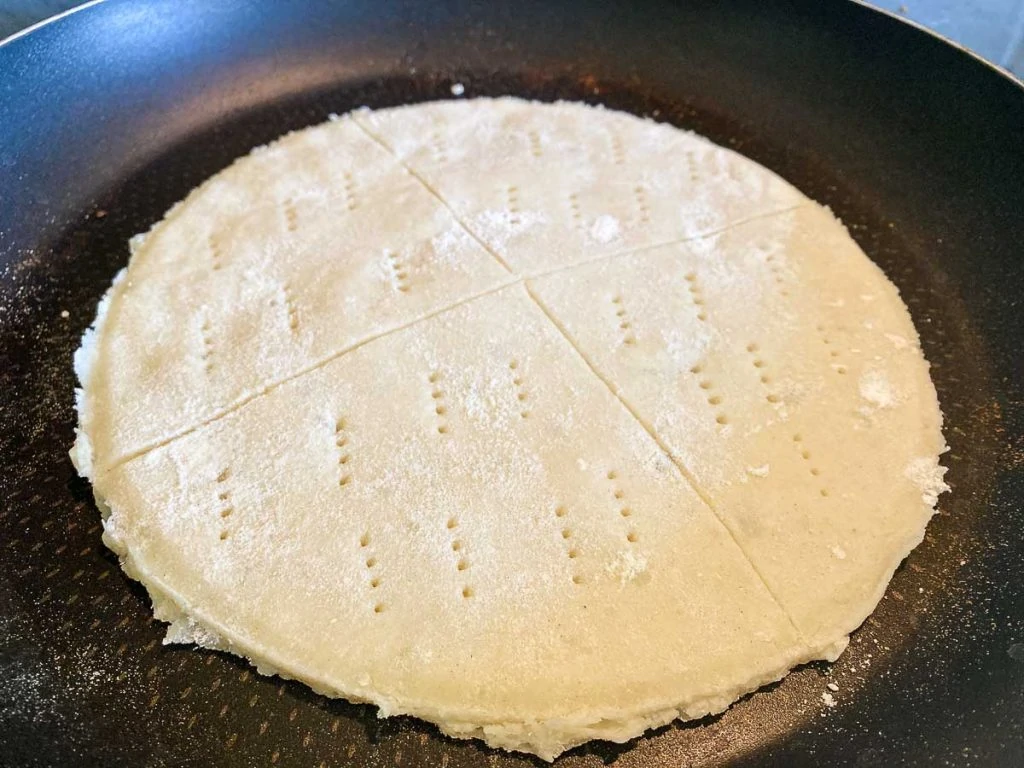
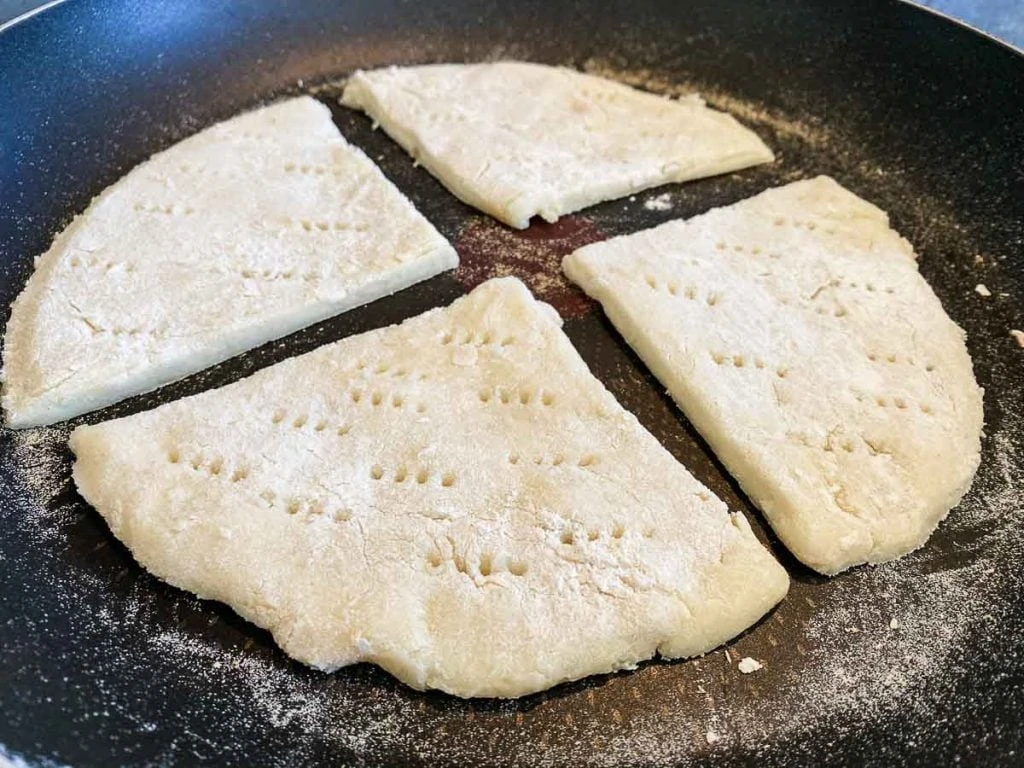
Preheat the pan on a high heat and then reduce the heat to medium when you put them in.
Use a hot, dry pan, rather than frying in butter. This is because when you’re doing multiple scones the butter will burn and you’ll be left with that taste on the scone. A light dusting of flour will stop them from sticking.
Fry for 3-4 minutes each side, depending on thickness. You can flip more than once and should keep an eye on them so they don’t colour too quickly on the outside without heating and cooking through the middle. If they start to brown too quickly turn your heat down.
Remove and eat!
You can then eat them freshly cooked straight from the pan or return to them to the pan with a little butter to fry, adding a little more flavour and crispness. You can, of course, save them for later to reheat in a buttered pan or even in the toaster.
Our top tips for getting the perfect tattie scones
- Use freshly boiled or still warm floury potatoes, rather than old mash.
- Allow the potatoes to air dry after boiling before moving on to the next steps.
- Let the dough sit for a few minutes to cool slightly if the potatoes are still really warm, as it’ll make it easier to work with.
- Keep flipping and flouring the dough as you push and flatten it into a circle
- Use a dry pan rather than a greased one.

Tattie Scones Printable Recipe Card
Traditional Scottish Tattie Scones Recipe
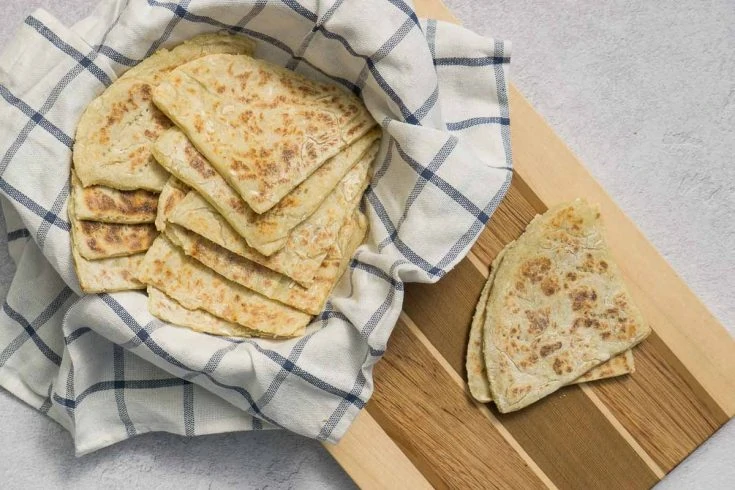
These homemade Scottish Tattie Scones are much better than the bought variety!
Use this quick and easy traditional recipe to make your own potato scones and enjoy them for breakfast or as a snack.
Ingredients
- 500g Potatoes
- 25g Butter
- 125g Plain Flour (1 cup)
Instructions
- Peel and boil potatoes, or boil with skins on and remove after. Use similar sized potatoes or cut to the smallest size.
- Drain potatoes and allow them to air dry for a few minutes
- Add in room temperature butter and mash into the potato. If you have a potato ricer you can use this instead and then mix the butter in.
- Add the flour a few tablespoons at a time until it forms a stiff dough. You may not need to use all of it.
- Turn the dough out onto a floured surface and separate into 3 balls. If the potatoes are still hot or very warm then allow to cool slightly before moving on to the next step.
- Take each ball and pat it out into a flat circle, constantly turning and lightly flouring each side so that it doesn't stick. Once it's big enough you can use a small plate on top to cut the rough edges into a perfect circle. Remember to keep turning and flouring.
- Prick all over with a fork and then either cut into four or score but don't cut right through. If your dough is holding together well you can fry it as one large round and then cut after, or if you find it easier fry the tattie scones separately.
- Heat a large, flat-bottomed pan on the stove until hot, then turn down to a medium-low heat. Do not grease the pan as the butter will end up burning. If your scone is lightly dusted in flour it won't stick.
- Use a spatula/fish slice to move the scone/s into the pan and fry on each side for 3-4 minutes. Keep an eye on the colour and if it's browning too quickly then turn the heat down. You can flip more than once.
- Remove and allow to cool before eating with butter and jam if you like, or return to the pan with some butter to fry. The scones can be kept in an airtight container and fried later or warmed in the toaster. They can also be frozen.
Notes
Preferably use King Edwards Potatoes or a floury type of potato. The amount of flour you use will be dependent on how floury the potatoes are, and you'll also need a little additional flour to dust over the dough as you smooth it out into rounds.
Nutrition Information:
Yield:
12Serving Size:
1Amount Per Serving: Calories: 92Total Fat: 2gSaturated Fat: 1gTrans Fat: 0gUnsaturated Fat: 1gCholesterol: 4mgSodium: 18mgCarbohydrates: 17gFiber: 1gSugar: 1gProtein: 2g
The nutritional data in this recipe is provided by a third party and these values are automatically calculated and offered for guidance only. Their accuracy is not guaranteed.
Other Similar Scottish Recipes to Try
- Simple Scottish Bannocks Recipe
- Easy Scottish Oatcakes Recipe
- The Perfect Scottish Morning Rolls Recipe
- Butteries Recipe
Pin for later!


Mmm these sound yummy and I imagine them being light and fluffy so I will havevto give this recipe a try. I like your easy to follow instructions and tips. Thank you.
You’re welcome glad you enjoyed it!
Tatties definitely do not originate in scotland!!
Whoops, you’re quite right Roger. We’re glad you’re so on the ball. We meant the tattie scone originated in Scotland not the potato, we’ve made our post clearer now to avoid any potato-based origin issues! 🙂
The earliest recorded trace of the spud was found in the Peruvian Andes at around 6000BC. I think they were in Glasgow about 2 weeks later lol
These are one of my favourite foods. I make them from leftover mash sometimes but usually just buy them in the supermarket and leave them in the freezer. I often have them for a quick breakfast. I heat them in the microwave straight from the freezer and have them with butter or a fried egg. I’ve never tried them in the toaster but will do now. In England they’re called potato cakes and are easy to find in supermarkets though they’re not a traditional English food and it seems to be only my friends with Irish families who eat them. My dad’s from Northern Ireland so I grew up eating them. My dad and my aunts and uncles always call them ‘slim’, but I don’t know if that’s a common name for them in Ireland or not. I’m glad you pointed out not to use an egg in the recipe. Lots of online recipes do include an egg but as well as not being authentic that would completely change the texture.
Hi Anne,
It sounds like you really know your tattie scones! We had them in England and in Northern Ireland, so good with breakfast! We really hope you find our recipe lives up to the ones you’ve had with your Dad 🙂
Phil & Sonja
Our local bakery used to make oatmeal tattie scores which were delicious, but I have never seen a recipe for them!
You can buy oat flour in larger supermarkets and other shops – that’s all you need x
Going to make these babies this morning. Thanks for the recipe and the tips. I’ve had these (fadge) in NI and just love them.
You’re welcome! Hope it goes well!
Just another PERFECT recipe from Scottish Scran!! I have made the tablet and now the Tattie Scones and cannot believe how easy (SO well-explained!) and tasty your recipes are. Thanks so much.
This comment made us so happy! Thank’s so much for the feedback. It’s so lovely to hear that you like our work! And get to enjoy tasty treats too 😀
Finally I see the proper recipe for potato scones. I have to laugh people adding egg and milk, when during the war eggs and milk were rationed.
If I may add a comment: in relation to adding the eggs and milk …. when I introduced solid food to my babies I did add milk and egg to my “mashed potatoes” and the leftovers were then made into scones. I also “dried “ the potatoes by putting them back on the burner; shaking the pot on the still warm burner, thereby drying them quicker. After all the bairns were waiting for there t’attire scones!.☺️
Drying the potatoes is a great idea, we often leave them to steam but haven’t tried drying them. Thank you for your kind words we hope you like some of our other recipes too!
Hi, very like my recipe, I sometimes grate the tattie, I bake a lot and wonder if you have a recipe for Scottish plain bread? I know its a batch process, but I have never been ever to duplicate the taste. We left Paisley in 1967 for work reasons and I can still smell it, our mothers used to teeth us on the big end crust. Worked allover the world and can still smell it
We don’t yet but are working on a morning roll recipe, it’s proving tricky to get it just right…
Very little yeast and left to prove over night
Sounds like an interesting variation!
the 4:1 potato/flour ratio is the bomb, with a nob of butter. Personally I don’t use salt, instead I grate parmesan into it for added umami.
killer results, nice one.
That certainly would add extra umami! Great tip.
Thanks for the recipe, although P.S.. it’s no ‘tottie’ in Glasgow, it’s ‘tattie’ in Glasgow, with ‘tottie’ being more common over east coast 😉
That is strange, we have a host of people that have told us the opposite. The joys of so many different dialects in such a small space we suppose. Either way, we hope you enjoy the recipe!
No you are wrong I’m an 89 year old woman I grew up in Aberdeen it was always tatties but my brother in law from Glasgow always said totties as does my friend from Paisley!
hi fantastic recipe I’ve often heard of tattie scones but never actually eaten them. being from Australia don’t be surprised. I will definitely be cooking them very soon. your information and instructions are brilliant. thank you. 😈
Thanks! Hope you enjoy them!
One of my favourite breakfasts, a lorne sausage n tottie scone doubler on a well fired roll washed doon way a can of Irn Bru.
These look absolutely amazing, were doing the NC500 soon and can’t want to try all the food!
Plenty to try! Keep an eye out for these with breakfast, and for Cullen Skink for lunch!
I’ve never had these, nor made them, before today. I’m really intrigued by all the dishes in this blog.
Thank you for the recipes. My tattie scones came out great and we really enjoyed them. I’ll make them again.
That’s great to hear thank you! We’re so glad you enjoyed them.
THE BEST THING I EVER TASTED. WOULD PURCHASE THEM & MEAT PIES, LORNE SAUSAGE, RAISIN SQUARES & EMPIRE BISCUITS AT DREWES ON 4TH AVE., 69th STREET IN BROOKLYN. WHEN THEY WENT OUT OF BUSINESS I GOT THE TATTIE SCONES AT HANNAH SIMONSENS ON 8TH AVE,, WHEN HANNAH GAVE IT UP, I MADE THEM. THEY WERE GREAT. NORWEGIAN STORES HAD THEM FROZEN. I THINK THEY CALL THEM PATOSE(?) KAKER. THEY WERE HARD AROUND THE EDGE. DIDNA LIKE THEM. I AM AMERICAN, MY MOTHER WAS FROM PAISLEY. BEEN THERE, GREAT PLACE.
I make tattie scones a lot. I always mash my potatoes with my electric hand mixer and add butter and milk before serving but next time I make the scones I will mash them with my good old potato masher and try your scone recipe. Always wondered if the potatoes should be warm or cold but warm are so much easier to work with. Thank you, enjoy your recipes. 🇨🇦🏴
Back in the day when I still had some black hair instead of white, on Sundays we used to go to our ‘aunties’ for lunch – normally a cold meat buffet. The two of them lived in an old ‘miners row’ – one bedroom, one living room, one toilet and one tiny kitchen. Auntie Jean always made tattie scones for us. They were really thin and could be loaded up with cold meat, cheese etc. then rolled up (not folded) and shoved down your neck. All of her cooking was done on a paraffin stove with one pan/pot station at the top. No idea how she ever managed, but the tattie scones were truly brilliant.
What a step back in time, John thanks so much for sharing. We have no idea how she managed it either!
Iove your method will try soon, but on your Scottish breakfast description, we very seldom use haggis but we certainly use “fruit pudding” fried along with the other ingredients!!!
Bernie
Rub flour on your rolling pin if it sticks. I do this when making Shetland Bannocks and have no problems rolling the dough which is a bit sticky! I also flour my hands when mixing.
These are delicious, and I love that this recipe is so easy to follow and has great tips too.
As a Scot, I have to point out that many of us feel baker beans in a fry up makes it a full English. (Of course plenty of people have other opinions). Personally for me it’s: tattie scones, bacon, fried egg, Lorne sausage, fried tomato, black pudding slice fried, fried mushrooms, slice haggis fried, toast…if you’re being extra fancy, you’d have a slice of fruit pudding or stale clooty dumpling fried as well (but dumpling never lasts long enough to go stale in our house) and the fruit slice/dumpling is usually an Xmas thing.
Also, not sure if you mention it, but many of us eat them “raw”, ie they don’t get a second fry, just the initial one. We eat them cold with a thick spread of salted butter on them.
This is a great recipe, thank you! My great auntie used to make amazing tattie scones, I’ve tried to make them before but they’ve never been that great but these tasted almost as good and we’re delicious, my family agreed. The tips were very helpful too.
We’ll happily take almost as good as high praise indeed! Thank you
Are you sure they were first made in Scotland?
Actual scones (“scon” = a quick bread, Scone “Scown” is a village, scone also “scown” is a small stone) are certainly original traditional Scottish food (first recorded around the year 1513AD) but, I have never heard of that farls claim before.
Farls?
That is what we called them in the 1970’s. That is the real name for “tattie scones”. The word farl means 4, as you scotch the “tattie scone” dough into quarters when making them.
I know that farls are as much Irish as they are Scottish but, who did it first?
Any reason they couldn’t be formed using a tortilla press? I think they’d be too fragile to try to hand-pat (as in tortilla forming) but with greaseproof paper or parchment liners on both of the press plates , they should be easy to form. will give it a try. My dad’s ancestors were estate workers from near Hadrians Wall in Northumberland. Probably had something like this, back a few centuries.
We’ve never tried to be honest! We definitely think you’d need some kind of baking paper, but you could give it a go!